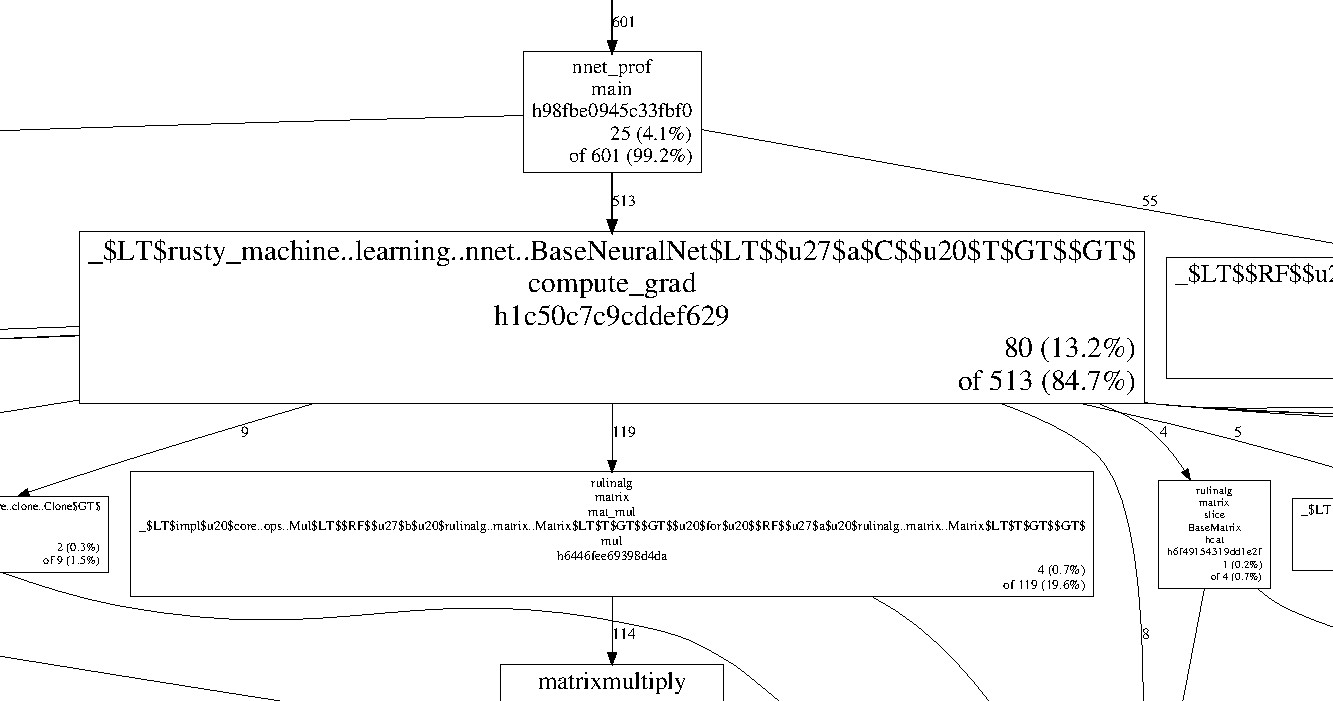This code is an extension of the work in AtheMathmo/cpuprofiler.
This library provides bindings to Google's gperftools.
There are other profiling tools for Rust, cargo-profiler is particularly good! This library certainly doesn't replace those but adds a some different tools to the mix:
- Makes it easy to profile only sections of code.
- Uses statistical sampling wwhich means low overhead.
- Works with pprof for a range of output formats.
- Allows memory profiling out of the box (on linux and macOS).
In order to use this library you will need to install gperftools. There are instructions in their repository but it's roughly the following:
- Download package from releases
- Run
./configure - Run
make install
There may be some other dependencies for your system - these are explained well in their INSTALL document. For example libunwind (> 0.99.0) is required for 64 bit systems.
Add gperftools to your Cargo.toml manifest.
[dependencies]
gperftools = "0.1.0"
Add the dependency to your root:
extern crate gperftools;
Start and stop the profiler around the code you'd like to draw samples. This will save the profile to a file you specify.
// CPU
use gperftools::profiler::PROFILER;
PROFILER.lock().unwrap().start("./my-prof.prof").unwrap();
// Code you want to sample goes here!
PROFILER.lock().unwrap().stop().unwrap();
// HEAP
use gperftools::heap_profiler::HEAP_PROFILER;
HEAP_PROFILER.lock().unwrap().start("./my-prof.hprof").unwrap();
// Code you want to sample goes here!
HEAP_PROFILER.lock().unwrap().stop().unwrap();Now you can just run the code as you would normally. Once complete the profile will be saved to ./my-prof.prof.
The final step is the fun part - analyzing the profile!
To use the heap profiler, a custom allocator is used. This feature requires setting the feature heap, to enable it. When enabled the global allocator will be changed to use tcmalloc, which is required for gperftools to analyse allocations.
You can find additional documentation about heap profiling here.
For a reproducible example of the heap profiler used on the rust-fil-proofs repository see the rust-fil-proofs-profile Docker image.
To analyze the profile use Google's pprof tool.
You can find some documentation on how to use it with gperftools here.
If you have issues with smybols not being displayed make sure
- you enable debug symbols (
RUSTFLAGS=-g) llvm-symbolizeis in your path
The output format is entirely dependent on pprof but here are some examples from a Rust program:
Total: 855 samples
207 24.2% 24.2% 207 24.2% matrixmultiply::gemm::masked_kernel::hfdb4f50027c4d91c
156 18.2% 42.5% 853 99.8% _$LT$rusty_machine..learning..optim..grad_desc..StochasticGD$u20$as$u20$rusty_machine..learning..optim..OptimAlgorithm$LT$M$GT$$GT$::optimize::h2cefcdfbe42a4db8
79 9.2% 51.7% 79 9.2% _$LT$$RF$$u27$a$u20$rulinalg..vector..Vector$LT$T$GT$$u20$as$u20$core..ops..Mul$LT$T$GT$$GT$::mul::h21ce4ecb4bbcb555
66 7.7% 59.4% 73 8.5% __ieee754_exp_sse2
61 7.1% 66.5% 95 11.1% _$LT$rusty_machine..learning..toolkit..regularization..Regularization$LT$T$GT$$GT$::l2_reg_grad::h4dff2e22567a587e
57 6.7% 73.2% 274 32.0% matrixmultiply::gemm::dgemm::h2d985771431fcfd4
41 4.8% 78.0% 42 4.9% _$LT$rulinalg..matrix..Matrix$LT$T$GT$$GT$::transpose::h736b18b122958bcd
31 3.6% 81.6% 32 3.7% sdallocx
The first column is the number of samples from each function. The second is the percentage of samples which were found directly in this function, and the third column is the percentage of samples which were in this function or it's children. I think...
Below is a snippet of an interactive graph output.
The above graph is produced by pprof and shows which functions the samples belong too.
In the above we see that there were 513 samples in the compute_grad function and 119 of these were matrix multiplication.
- Better crate documentation
- Expose other functions
This project has a BSD license to match the gperftools license. Which makes sense, I think?


